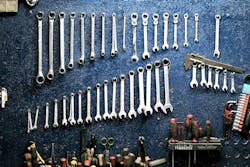Once Jerome George, parts and service director of operations for Village Toyota-Cadillac (a part of Dimmitt Automotive Group) in Homosassa, Fla., has spent time observing the operations and identifying the areas that need to be fixed (which he refers to as a blueprint), he begins creating a plan of action.
“As I’m creating that blueprint, it gives me a complete guideline for that store and how it’s performing,” George says.
Once George has found the areas that need to be addressed, he creates a customized roadmap for everyone on the team—including himself.
“I give them all a roadmap to show them the direction that I’m heading,” George says of his strategy for turning fixed operations around.
Each person within fixed operations will get a blueprint with areas with which they struggle. The road map includes action items, benchmarks and deadlines to keep everyone on the same page to get the dealership back on track. George shares a few examples of what that roadmap may look like for different positions within fixed operations:
Service advisors:
The service advisor will have all of the areas that they struggle in addressed on their personalized road map. For example, if they’re not selling cabin or air filters, it will be on the sheet and show them exactly where they fall short compared to goals and other advisors, explains George. Their road map also ties them into departmental gross for the month, so they can see where they track versus what the growth increase should be. This allows service advisors to see where they are at any point in time.
Parts Manager:
The parts manager’s road map will take a look at the parts inventory and, in particular, how he or she is running on the day supply.
“A lot of managers try and overstock certain areas but in today’s environment, we can get parts so fast, so let’s keep our parts warehouse with a larger base rather than having so many of one thing,” George says. “Fifty brake pads doesn’t make sense. Ten different types of tires from the same manufacturer doesn’t make sense.”
A good parts manager, according to George, should control parts movement. So, for example, if he’s outside the 12-month window on $20,000 worth of parts. George gives a deadline for when the parts need to be moved and then he sets up an accrual account that accrues money each month based off of parts performance. Rather than taking a loss on parts, the department can get paid something for the part, such as 50 cents on the dollar.
The roadmap that George creates will show the parts manager how to lean out and expand the inventory so there’s more value.
“The roadmap shows him how to get back on track,” George says.
For a department that’s in terrible shape, the parts issue can be huge, so George says it’s important that once the inventory is in check, immediate compliance must take place and the inventory must remain in balance to avoid the issue happening again.
“From that day forward, you must manage it,” George says on what is expected of his parts managers. “If you don’t manage it, you’re not going to be employed anymore.”
Shop Foreman:
The goal with the foreman’s roadmap is to increase productivity, explains George, so he analyzes each technician to see the amount of hours that are turned. Then, he puts bonuses in place and puts a plan in place to restructure the team as needed to create the most efficient department possible.
Warranty Admin: The roadmap for the warranty admin shows what exactly needs to be done in order to get claims paid faster so that money gets to the dealership quicker, explains George. George explains that in his experience, he’s never walked into a dealership where technicians don’t overclaim time or fail to perform proper procedures every time so this is an area that most likely will need to be addressed so the dealership can get its debit back.



